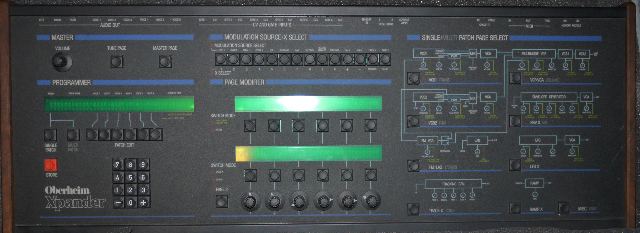The Oberheim Xpander is a desktop version of Oberheim Matrix-12 and was an analog synthesizer launched by Oberheim in 1984 and discontinued in 1988. It is essentially a keyboardless, six-voice version of the Oberheim OB-8 and Matrix-12 (released a year later, in 1985). Utilizing Oberheim's Matrix Modulation technology, the Xpander combined analog audio generation (VCOs, VCF and VCAs) with the flexibility of digital controls logic.
The Xpander "Owner's Manual, First Edition" describes the technology as this:
"An analogy to the Matrix Modulation system might be all of those millions of wires that existed on the first modular synthesizers. As cumbersome as all of that wiring was, it allowed the user to connect any input to any output, resulting in sophistication and flexibility unmatched by any programmable synthesizer...until now."
Each of the six voices of the Xpander is completely independent. That is to say, each could be configured to create a different timbre - this is accomplished via the multi-patch mode which will be described below.
Starting at waveform generation, each voice has two voltage controlled oscillators (VCOs). Each of which is capable of generating sawtooth, triangle, pulse or noise waveforms. Furthermore, the "duty cycle" of the pulse width can be modulated as well. Although perhaps better known for subtractive synthesis, the Xpander is also capable of frequency modulation (FM) synthesis by modulating VCO #1 with VCO #2.
Moving on from the VCOs, the signal then passes through a multi-mode voltage controlled filter (VCF). The available modes on the filter are:
one-, two-, three- and four-pole low passone-, two and three-pole high passtwo- and four-pole band passtwo-pole notchthree-pole phase shifttwo- and three-pole high pass plus one-pole low passtwo-pole notch plus one-pole low passthree-pole phase shift plus one-pole low passFrom the filter, there are two sequential voltage controlled amplifiers (VCAs) through which the signal must pass. And finally the audio is delivered to a variety of outputs: mono, stereo and six independent outputs (corresponding to the six voices).
Of those analog audio components (VCOs, VCF and VCAs), each can be modulated by several different digital controls.
ADSR Envelopes - each voice can have up to five envelope generators. Each envelope is of the standard Attack-Decay-Sustain-Release model (ADSR), with the addition of an initial Delay phase, thus making them DADSR envelopes, to be exact.Low Frequency Oscillators (LFOs) - each voice can have up to five LFOs applied. Each LFO can have a different waveform: triangle, square, up-saw, down-saw, random or noise. Additionally, a sampling mode is provided, whereby an independent source (e.g. a different LFO) is sampled at a set frequency.Lag Generator - the lag function is similar to portamento on traditional synthesizers. However, the lag modulation in the Xpander can be applied to any control or audio signal.Ramp Generators - each voice can have up to four ramp generators. Similar to the attack portion of an ADSR envelope, the ramp generates a linear signal from zero to the user-defined ramp height.Tracking Generators - there are three tracking generators available for each voice. The tracking generator provides a mapping from a control source (e.g. key range on the keyboard, or volume pedal, or mod wheel) to a modified output, based on the user-defined settings of the generator.Famous Users and Example Uses
Vince Clarke - On everything by Erasure until 2005. You can hear it very clearly on the 12" mix of "Sexuality", for example, at the start, and mid and low end parts (filter sweeps, etc.). He actually has two of them, and used them for the chorus tour in 1991 - 1992, which was mostly old analog synths. On early tours the Xpander was introduced as a member of the band as can be heard on live versions of Oh L'amour.Sasha - Whose track "Xpander" was written in homage to the instrument. That supersaw style sound, originated using the Xpander's filtering and multi/unison and stacking capabilities.Nitzer Ebb - Extensive use for basslines on "Belief".Depeche Mode - Have two of them, and can clearly be heard on everything from It's Called A Heart and Black Celebration onwardsSteve Roach - Everything from Empetus (1986) on.Daniel Miller - Has one in the Mute worldwide programming studioHuman League - All over the mid 80's period & onward albumsJuicy Audio Productions(Shekhar Raj Dhain) - Stars of Oryeon Album . Also film & T.V. work.Hans Zimmer - Sprinkled on various scores for films.Orbital - Everything from the first self-titled album onwardTangerine Dream - Everything from Le Parc onward.The Chemical Brothers - Can be heard in a lot of their music post 1995Meat Beat Manifesto - In a lot of their remixesTodd Tamanend Clark - From 1985 to the present.Nine Inch Nails - Including an Xpander modified for use with external inputsClarence JeyDie KruppsMNDR - "Feed Me Diamonds" AlbumCeephax Acid Crew- Used on multiple tracks.Sota Fujimori Used one in his college years, as well for many musical productions.
